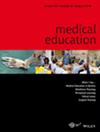Role of nurses in moderating the emotional dynamics in the clinical learning environments: Implications for medical students' experience
Abstract
Introduction
Existing literature recognises that health professionals' socialisation in the workplace involves an emotional component, including management of feelings as per professional expectations and demands. However, there is limited understanding of the emotions-related processes involved in the interprofessional educational space of the clinical learning environment (CLE) and the role of nurses in moderating the emotional dynamics. This paper explores ways in which emotions operate in the interprofessional encounters of the CLE, utilising Hochschild's theory on emotional work.
Methods
An ethnographic approach was adopted that included 120 hours of observations conducted in two hospital wards hosting clinical placements for medical students and 36 individual interviews with staff and students populating these clinical sites. Key themes were derived using the circular process of ethnographic data analysis utilising the sensitising concepts of emotional labour, emotional gifts and feeling rules, together with the relational dimensions of interprofessional interactions in the CLE.
Results
The following key themes were identified: emotional gifts from nurses to medical students and junior doctors, interprofessional interactions suggesting a breach in feeling rules and suspension of interprofessional hierarchies that engendered goodwill and appreciation among health care teams in the CLE. Interconnected subthemes highlight the nurses' efforts to maintain the sentimental order in the CLE through generously gifting emotional support to students and doctors in a variety of situations, impacting their professional socialisation and well-being. However, workplace stresses such as time pressures and staff shortages created interprofessional tensions, generating negative emotions. Blurred professional boundaries and professional humility positively impacted interprofessional dynamics and student experience in the CLE.
Discussion
This ethnographic exploration of the CLE revealed the emotions-related processes nested within the interprofessional space of health care practice. In their work towards emotional housekeeping of the CLE, the nurses offer emotional gifts to medical staff and students populating the ward. Workload issues and inadequate staffing influence both cognition and behaviour adversely, impacting interprofessional dynamics. Our findings support fostering professional humility as a pedagogical tool so that we collectively move away from current structures that keep us siloed.




 求助内容:
求助内容: 应助结果提醒方式:
应助结果提醒方式:


